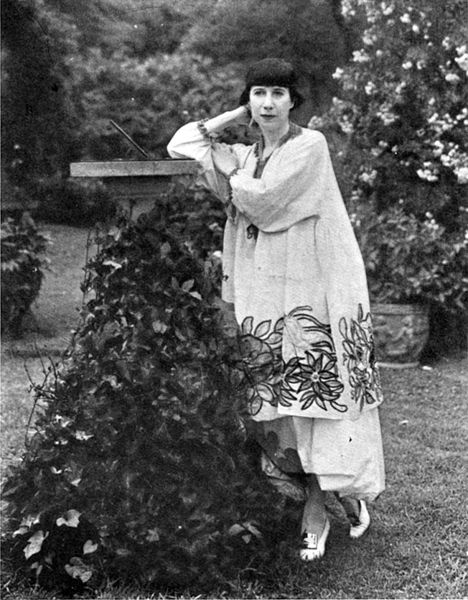
Florine Stettheimer, c 1917-20
Columbia University, Rare Book and Manuscript Library
It is often said that Florine Stettheimer, an early-Modernist painter of extreme originality and wit, lived a charmed life. Born to a wealthy German-Jewish family in New York in 1871, she was one of five children. Early on, her father left the family; she and her siblings grew up mostly in Europe. Stettheimer returned to New York in the early 1890s to study at the Art Student’s League, after which she returned to Europe, where she traveled extensively and studied art in Paris and Munich. In 1914, on the eve of World War I, she returned to New York with her mother and two sisters—Carrie and Ettie—and the family settled into an apartment in Alwyn Court on West 58th Street, near Carnegie Hall. There, Stettheimer and her sisters established a legendary salon that was frequented by many of the most important creative people of the time—among them, Marcel Duchamp, Carl Van Vechten, Gaston Lachaise, Sherwood Anderson, Edie Nedelman, Virgil Thompson, Edgar Varese, Georgia O’Keeffe, Alfred Steiglitz and the art critic Henry McBride.
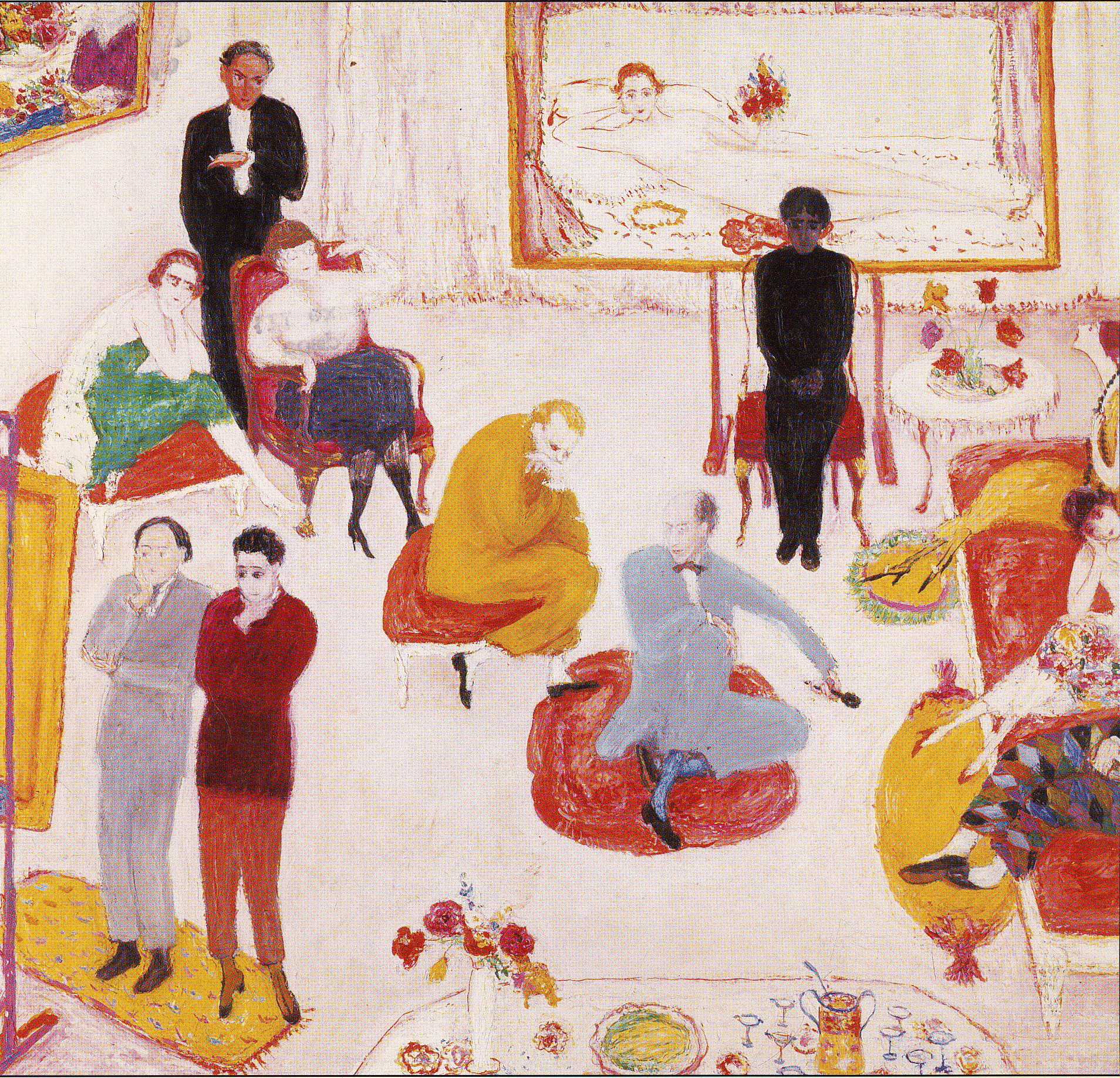 Florine Stettheimer, Soiree, 1917-1919
Florine Stettheimer, Soiree, 1917-1919
Beinecke Library, Yale University
In 1916 the Knoedler Gallery in New York mounted a show of Stettheimer’s work which was a critical and financial disaster. This disappointment, while keenly felt, fortunately pushed Stettheimer to leave behind her tentative, somewhat derivative post-Impressionist style and move on to what was to become her mature work. However, after this disappointment, she mostly showed her work in small group shows or privately at her studio, rarely showing her paintings publicly and refusing to put any of her work up for sale. Before her death in 1944 at the age of 73, Stettheimer asked that her family destroy all of her paintings—fortunately, they did not. In 1946, two years after her death, and at the suggestion of one of her closest friends, Marcel Duchamp, a retrospective of her work was mounted at the Museum of Modern Art in New York. The show was curated by another friend, art critic Henry McBride. Although critics of the time acknowledged her as as a very important Modernist painter of the early 20th century, and she had the respect and admiration of many of her peers, her paintings then disappeared from view until 1995, when they were exhibited at the Whitney Museum of American Art. This show, Florine Stettheimer: Manhattan Fantastica, included early work, her most fully-realized post-1915 pieces as well as her theater and costume designs, dolls and collages.
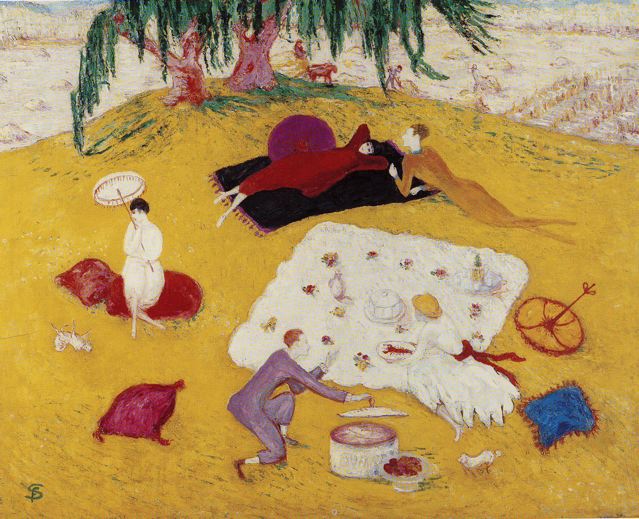 Florine Stettheimer, Picnic at Bedford Hills, 1918
Florine Stettheimer, Picnic at Bedford Hills, 1918
Pennsylvania Academy of the Fine Arts, Philadelphia
Stettheimer’s paintings are deeply personal—her main subject matter was her family and friends and the rather dreamy world of pleasure they inhabited. In her dazzling and eccentric paintings, with their bold color and openly feminine sensibility, Stettheimer created a unique synthesis of things she studied and loved—one catches glimpses of medieval portraiture, Persian miniatures, Brueghel, early Renaissance painting, Velasquez, children’s art, theater design, Matisse, Surrealism, Symbolism, folk art, fashion illustration, decorative art and interior design. She combines high/low elements in vivid constructions that depict scenes in a non-sequential, dream-like way—she played with perspective and her people and objects often float languidly through a complex universe of multiple narratives that have an allegorical quality. Her use of color was extraordinary, very American, and a complete break with the naturalistic earth tones of European painting. She favored deep reds, blacks, vivid pinks, vibrant blues and deep yellows, often in contrast to strong whites or soft pastels. Her portraits of family and friends in sitting rooms, salons, and summer houses; at picnics, luncheons and soirees—emphasized and immortalized their individual talents and interests. A good example of this is her portrait, below, of the writer Carl Van Vechten, who sits in the center of the painting, surrounded by his cats, books, typewriter and myriad artifacts from his life and work.
Florine Stettheimer, Portrait of Carl Van Vechten, 1922
Beinecke Library, Yale University
And this portrait of her sister Effie, in which Henry McBride described her as looking “…wide-eyed, for the mystery of life…as happy a blend of her worldliness and spirituality as any psychiatrist could ask for.”
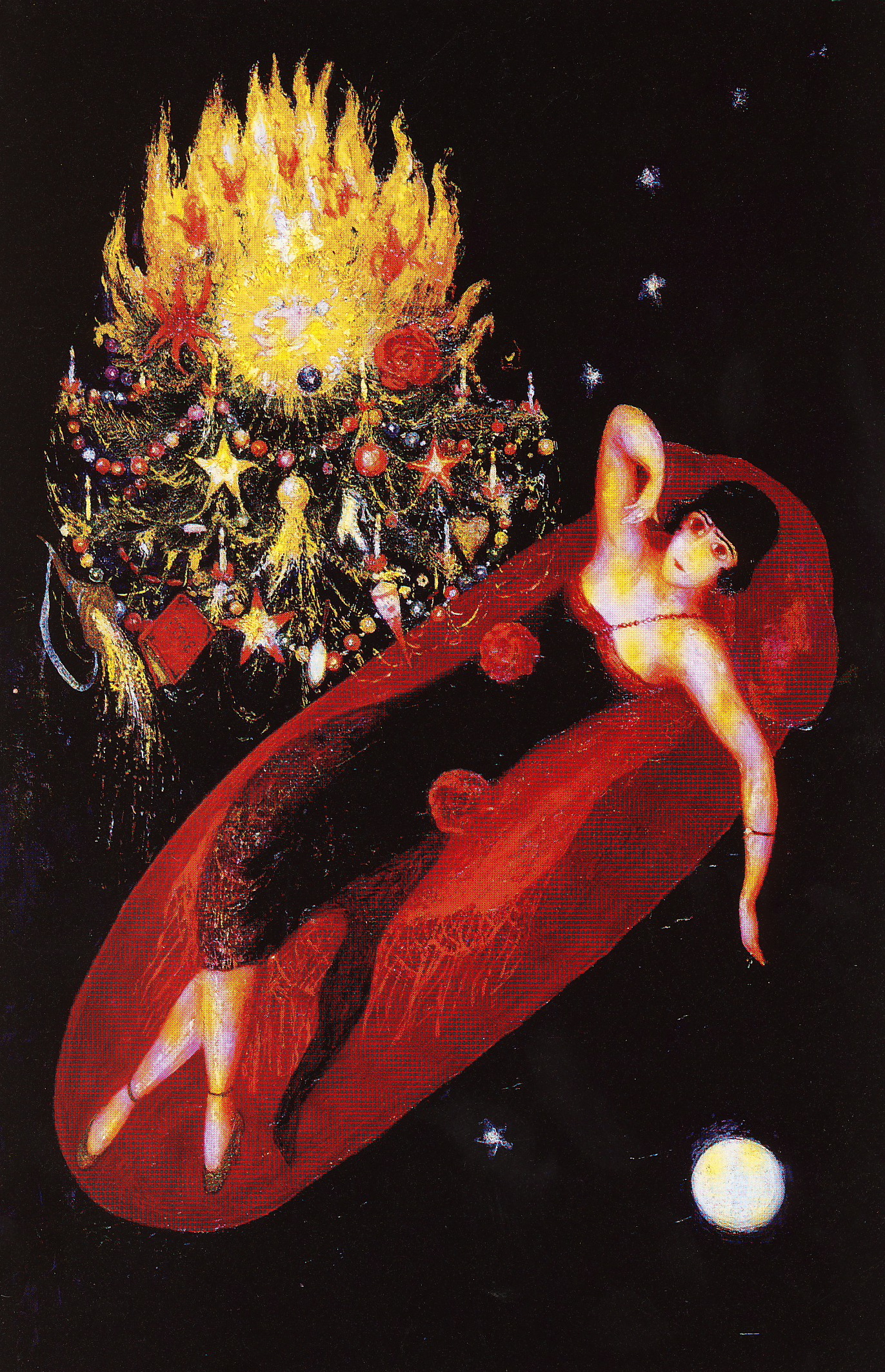 Florine Stettheimer, Portrait of My Sister, Ettie Stettheimer, 1923
Florine Stettheimer, Portrait of My Sister, Ettie Stettheimer, 1923
Columbia University
While Stettheimer made the decision to only show her work privately during her lifetime, she also suffered from the neglect and was resentful of the lack of recognition. Like many women artists, Stettheimer’s personal life has long overshadowed her art. Her work has been vilified as being too feminine, although, as Barbara Bloemink points out, in the prologue to her excellent book, The Life and Art of Florine Stettheimer, “it is difficult to imagine anyone criticizing a work of art as being too masculine.” There was also another obstacle to recognition by the art establishment–she made them uncomfortable. The art world is very inhospitable to independent artists whose work is idiosyncratic and who are neither part of any school nor followers of any group. In his 1996 article on Stettheimer in Art in America, Trevor Winkfield writes: “You can paint anything in New York, runs a well-known truism, as long as three other people are doing the same thing.”
 Florine Stettheimer, Heat, 1919
Florine Stettheimer, Heat, 1919
The Brooklyn Museum
Stettheimer also had an abiding interest in costume and set design. When she lived in Paris, she fell in love with Diaghilev’s Ballets Russes, which inspired her to write a story for a ballet, Orphee des Quat’z-Arts, in 1912. The ballet was never produced, but Stettheimer designed costumes and built some model sets—the Museum of Modern Art has 44 of the sketches (see below) in their collection, but not on view. In 1934, Stettheimer designed sets and costumes for the Gertrude Stein/Virgil Thomson opera,Four Saints in Three Acts. Very avant-garde for the day, she fashioned the sets from tinsel, cellophane and lace, apparently to great effect when lit to her specifications.
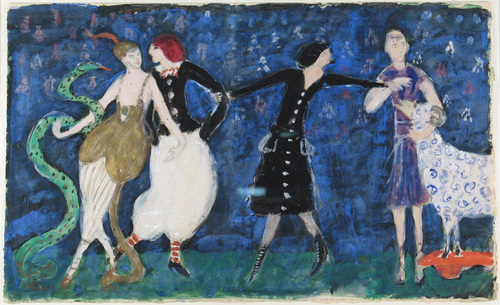 Florine Stettheimer, Euridice and Her Snake, Two Tango Dancers and St. Francis
Florine Stettheimer, Euridice and Her Snake, Two Tango Dancers and St. Francis
design for Orphee des Quat’z Arts, 1912
Gouache, watercolor, metallic paint and pencil on paper
In 1935, Stettheimer’s mother died, and Florine surprised everyone by moving into her studio in the Beaux Arts Building at 8 West 40th Street—living by herself, for the first time, at the age of sixty-four. The success and acclaim garnered from Four Saints, and her newly found independence, increased her self-confidence and spurred her on to a new phase of her work in which she re-worked old themes with a new sense of clarity and purpose.
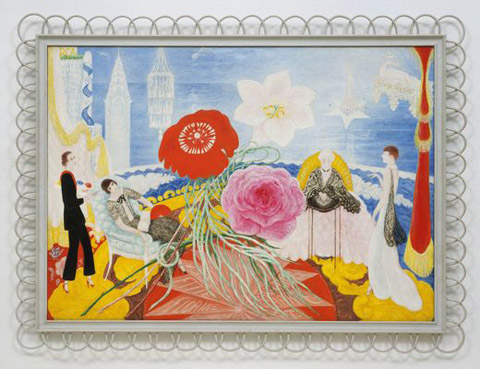 Florine Stettheimer, Family Portrait Number 2, 1933
Florine Stettheimer, Family Portrait Number 2, 1933
Museum of Modern Art, New York
Her last painting, unfinished at her death, The Cathedrals of Art, is a multi-narrative work, somewhat reminiscent of the structure of early Renaissance painting, that satirizes the power-brokering and competitiveness of the New York art world. The art critic Hilton Kramer later described it as “comic opera…the whole scene is one of shameless hustling and posturing. It is a prophetic as well as a delightful painting.”
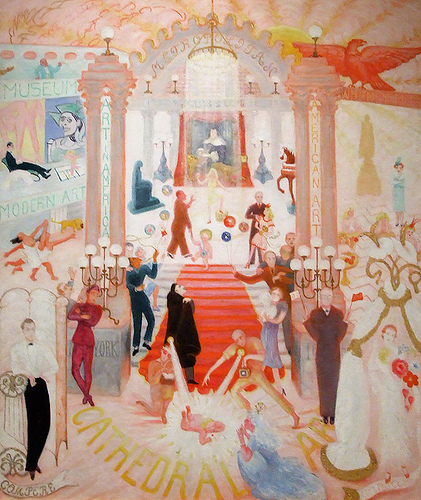 Florine Stettheimer, Cathedrals of Art, 1943-44
Florine Stettheimer, Cathedrals of Art, 1943-44
Metropolitan Museum of Art
Stettheimer was a dedicated, accomplished artist who was full of contradictions–she wanted to both avoid the critical spotlight and achieve recognition for her work. In her paintings and poetry she created and re-created the narrative of her life. In her imagery, narratives collide and split, time is erased and reordered. Perhaps this poem, published privately and posthumously in Crystal Flowers, 1949, gives us a glimpse into her elusive persona:
Occasionally
A human being
Saw my light
Rushed in
Got singed
Got scared
Rushed out
Called fire
Or it happened
That he tried
To subdue it
Or it happened
That he tried to extinguish it
Never did a friend
Enjoy it
The way it was.
So I learned to
Turn it low
Turn it out
When I meet a
stranger—
Out of courtesy
I turn on a soft
Pink light
Which is found
modest
Even charming.
it is protection
Against wear
and tears…
And when
I am rid of
The Always-to-be-
Stranger
I turn on my light
And become
myself.
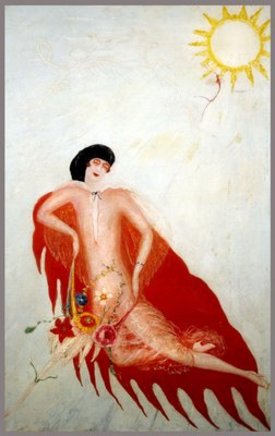 Florine Stettheimer, Portrait of Myself, 1923
Florine Stettheimer, Portrait of Myself, 1923
Collection, Columbia University, New York
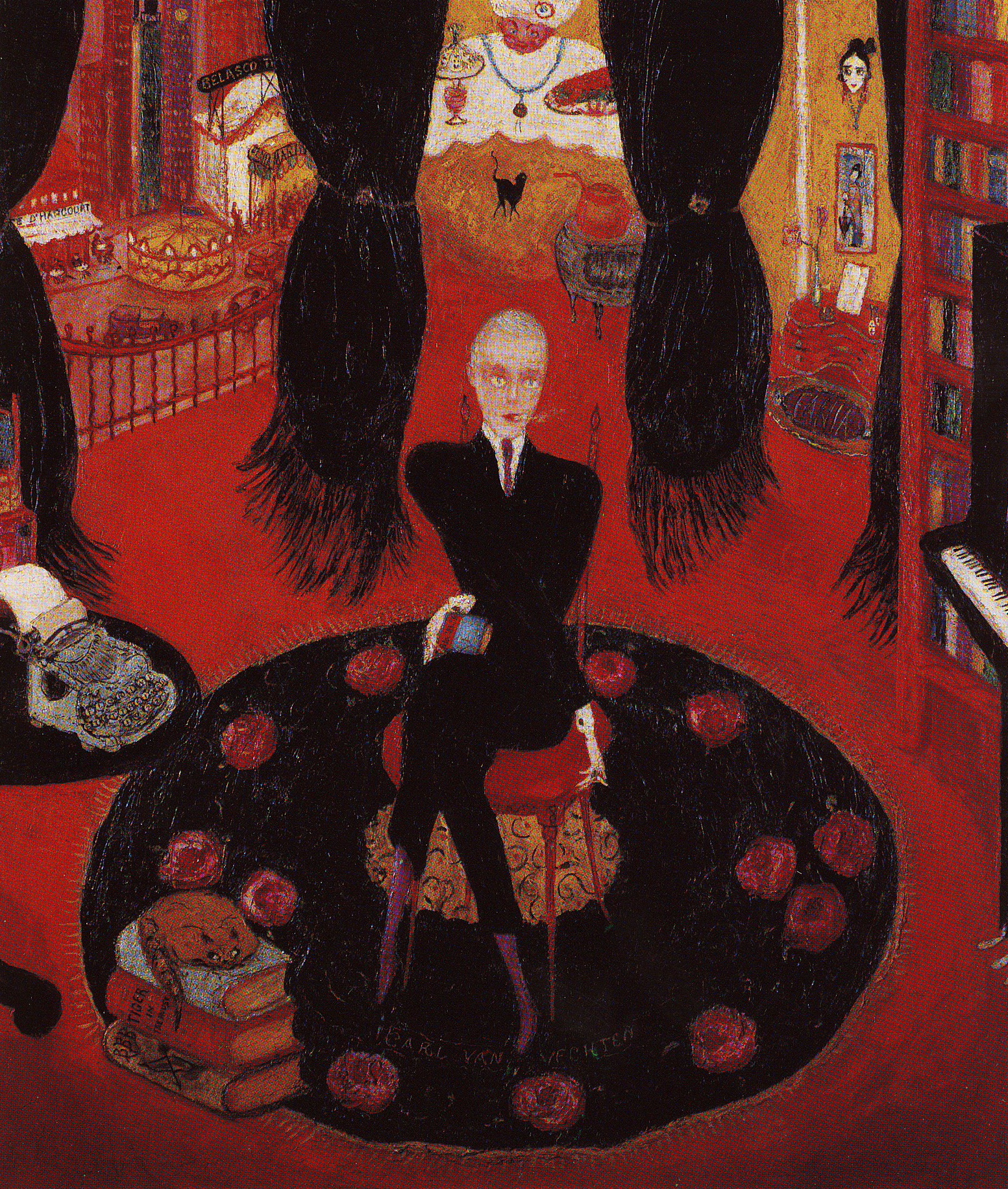
i am absolutely captivated by her work. i enjoyed this post very much. i always look forward to reading your blog.
Have you seen her work in person? Sad that opportunities are so infrequent. The Met does have her four-painting Cathedral series on display. Don’t know if Yale and Columbia have the ones her sisters left to them on display or not. I’ve heard they are quite fragile. MOMA may have some but I haven’t seen them, the only ones listed on their web site are her gouache/watercolor costume designs for the ballet she wrote , Orphee of the Quat-z-arts, which was never produced.
Her cathedral paintings are on display at MOMA. Specifically, I found her by turning a corner and being completely captivated by Cathedrals of Fifth Avenue. It was so rich; the gold metallic paint and vibrant reds. I loved the shape of everyone’s faces. I think she combined that paint with a lot of pencil work. It was fascinating. I hope you get a chance to see!
I’ve seen the cathedral paintings at the Met many times. I agree, there’s an immediacy and freshness to them and the line quality of the drawing helps create that effect. Though my favorites will always be her portraits of friends and family, especially the one of Carl Van Vechten, Marcel Duchamp, her sisters…
Christine, I didn’t know this artist – I’m so glad to be introduced – and I see why you like/admire her work. What a wonderful poem at the end too. V
What an elegant blog you have created! So pleased to see the feature on Florine Stettheimer..she is one of my favorite artists! Thank you! Elena
Christine, I’m mad for Florine Stettheimer’s work. I very much enjoyed reading what you wrote which tallies with the 1995 Whitney catalogue essays. On this visit to NYC I visited her Cathedrals paintings at the Met and
was blown away by them. I’m so happy the Met allows photography (sans flash) and photographed them all to look at at my leisure. On a trip two years ago to NYC, I went to the Whitney and sat for a long time in front of her painting which is in their collection; unfortunately I’ve forgotten it’s title.
Would you recommend Barbara Bloemink’s bio? What she wrote in that catalogue is rather boringly written. It would be wonderful to get one’s hands on the Parker Tyler bio, written at the suggestion of Stettheimer’s lawyer right after she died, but I think it was a very limited edition & thus probabbly difficult to find.
Glad I discovered your writing……
Susan
Susan, Thanks for your comments. I do wish that there were more of Stettheimer’s paintings on view in New York. I wonder if the ones at Yale can be viewed by appointment. I guess many are too fragile to be on permanent exhibition. You may know this, but her sister’s doll houses are at The Museum of the City of New York. http://www.mcny.org/museum-collections/new-york-toy-collection.html
As far as the Bloemink’s bio–I will read anything I can find about Stettheimer because there is so little out there, so yes, I’d say it’s worth reading. I see that there are several copies of Parker Tyler’s bio available used via Amazon, I may just order a copy…
Thanks for reading VR.
Christine
Yes, Christine, I did learn that The Museum of the City of New York has Carrie Stettheimer’s dollhouse on permanent display &
hope to get there on our next trip. Did you know that they sell a book of photographs of it, of each room, etc. for a mere $19.95? I’ll have to check out the Parker Tyler bio of Florine on
Amazon. I read that since he wrote the bio of her shortly after she died, he had access to the reminiscences of many of her friends & peers who outlived her. That should be interesting. Sorry for all the misspellings (typo’s) in my 1st comment — am a lousy typist. Keep me posted on yr adventures w/ Florine. The trio of sisters fascinate me. I’m going to google Ettie & see what she wrote.
Best,
Susan
I’ll be in New York in May, you’ve inspired me to renew my search for Stettheimer’s work that I haven’t seen before…
I did order the Tyler bio, looking forward to reading it.
Christine
Christine if your ever in Chicago, the Art Inst. off Michigan Ave. display selections of Florine Stettheimer’s Paintings that are always on view.
I am required to do research about a person (artist, musician, writer, ect.) from the jazz age. well i stumbled upon Florine’s work and am going to use one of her paintings from the 1920’s. I have found your blog very useful for facts about her and her artwork. I just wanted to thank you for writing this blog. :] (p.s. thanks to your blog I have now become a fan of her artwork, and not just for the project. Thanks again).
Love,
Zandria
Enchanted by her story and her art. Thanks for presenting more.
Christine, I happened to discover your blog on Florine after Googling Gaston Lachaise. I am a painter that has always stayed quite “realistic” in style but of late I have been exploring modern sculpture for ideas to help me simplify my style. Seeing Florine’s wonderful paintings are certainly a boon for me in that regard. Your blog is beautifully written and illustrated and I thank you so much for opening up my world a little bit more. With much regard, Eric Vose
“Discovered” Florine Stettheimer by reading about “Heat” in the recent NYT article “A World of Paintings in One City” (12.31.10). What an interesting person and fascinating artist! Wonder if she ever met the Swedish painter Nils von Dardel? Their styles are VERY similar – and they were contemporaries.Plus, von Dardel died in New York in 1943, a year before F.S. did.
Thanks for your comment. I was glad to see Smith highlighting Stetthemer’s wonderful work, although I found her repeated use of the word “eccentric” rather annoying, it’s an inherently dismissive remark often made about Stettheimer in particular, and about artists in general who don’t fit into any school or network or trend. I’ll never understand why artists who find their own individual path are undervalued, as if independence were an unworthy trait in an artist (not to mention disinterest in commercial success.) One always feels the words “amateur” and dilettante” are not far behind.
I knew nothing about the artist you refer to, Nils von Dardel. I’ll try to read more about him. I can see from a quick look at the images I found on the web the similarities you mention. But then after just a brief glance, they started seeming less and less similar—while they are both colorists, and his work also has that similar sense of anti-gravity, von Dardel’s work seems more one-dimensional and illustrative—to me, Stettheimer’s work has more of an edge, both a satiric and intellectual approach and emotional and psychological complexity. Stettheimer had a deep knowledge of art history and decorative art, and I see that richness, filtered through her own ideas, relationships and experiences, as bringing a complexity and richness to her work. Of course, I’ve spent a lot of time with her work over many years and after a short glimpse on the internet, it’s obvious that my reading of von Dardel’s work is extremely superficial, I will try to find out more about him when I have the time—thanks again for bringing him to my attention.
Meanwhile, I encourage you to read Bloemink’s book about Stettheimer and look at her work at the Brooklyn Museum, the Met etc., when you can—I think you’ll find it very rewarding.
Thanks again for your comments.
There is also Nil Dardel’s daughter, Ingrid von Dardel (1922-1962), whose work, I think, is closer to Stettheimer’s than her father’s. Ingrid von Dardel shares some of Stettheimer’s qualities (at least superficially), including how the hands are drawn — von Dardel’s are larger, but the shape is very similar to Stettheimer’s. Also the men in the her paintings have a fey quality. von Dardel appears to portray herself in some of the paintings, as did Stettheimer. Storytelling appears important to von Dardel, as does generous use of bright colors, all Stettheimer traits.
The perspective is unique, great for eye/hane cordination. Something like a athlete or dancer. Magical but not surreal.
Greetings to the arts researcher Christine, I am interested in the arts and I liked reading your article title (Fine & Decorative Arts, Textiles with tags Embroidered Textiles, Istanbul) I want to talk about the article ……..
alshaloi71@yahoo.com
Ran into one of Stettheim’s paintings yesterday and was fascinated. Thanks for the overview, the images, and the poem! I’d never heard of her before.
I stumbled on this article by accident, and was stunned that the first painting shown was not by our contemporary, Maira Kalman. There are such huge similarities in style it is stunning. Kalman has written an illustrated many books, some for children, some for adults. She’s done a monthly column for the NY Times, and has been very successful, perhaps because she didn’t aspire to succeed in the rarified world of fine art. If you don’t know her work, it’s easy to fine all over the web and in bookstores. Sad that these two never met. They have much in common.
Susan,
You might enjoy this VR post on Maira Kalman
Liz Hager